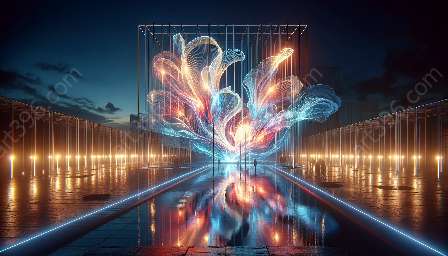Color theory in light art is a fascinating and integral aspect of the creation and appreciation of visual art, encompassing the science, psychology, and aesthetics of color. When applied to the realm of light art, color theory takes on a dynamic and transformative role, offering boundless opportunities for artistic expression and interactivity.
Understanding Color Theory in Light Art
Color theory in the context of light art involves the exploration of how different colors interact with light, how they are perceived by viewers, and how they contribute to the overall aesthetic experience. It encompasses the study of color properties, such as hue, saturation, and brightness, and the ways in which these properties can be manipulated through the use of light sources, filters, and other elements.
One of the fundamental principles of color theory in light art is the understanding of the color wheel and how different colors relate to each other. Artists and creators utilize this knowledge to evoke specific emotions, convey messages, and establish visual harmony within their light art installations.
The Role of Interactivity in Light Art
Interactivity in light art introduces a captivating dimension to the exploration of color theory. By allowing viewers to actively engage with the artwork, artists can create immersive and participatory experiences that transcend traditional forms of artistic expression. Through the use of interactive elements, such as sensors, motion detection, or audience input, the color dynamics within a light art installation can respond in real time to the movements and actions of the audience, fostering a deeper connection and engagement.
Furthermore, interactivity enables artists to incorporate dynamic color changes, transitions, and patterns, adding layers of complexity to the visual narrative. This fusion of color theory and interactivity amplifies the impact of light art, inviting viewers to become active participants and co-creators of the artistic experience.
Color Application and Techniques in Light Art
Color theory guides artists in the deliberate application of color within light art installations. Through the strategic placement of light sources, the use of colored gels, and the manipulation of light intensity, artists can orchestrate mesmerizing displays of color interplay and illumination.
Beyond static color compositions, advancements in lighting technology and digital programming have expanded the possibilities for intricate color manipulation and sequencing. This enables artists to create dynamic color gradients, pulsating patterns, and synchronized color shifts, enhancing the interplay between color theory and interactivity.
Appreciating the Impact of Color Theory in Light Art
The synergy between color theory and interactivity in light art yields a captivating and immersive experience for both creators and audiences. By delving into the principles of color theory, artists can infuse their light art with profound emotional resonance, visual intrigue, and narrative depth. Viewers, in turn, are invited to explore the nuances of color interaction, perception, and personal interpretation, fostering a deeper engagement with the artwork.
Ultimately, color theory in light art serves as a gateway to boundless creativity and sensory exploration, offering a rich tapestry of hues, tones, and visual narratives that transcend traditional boundaries of artistic expression.

